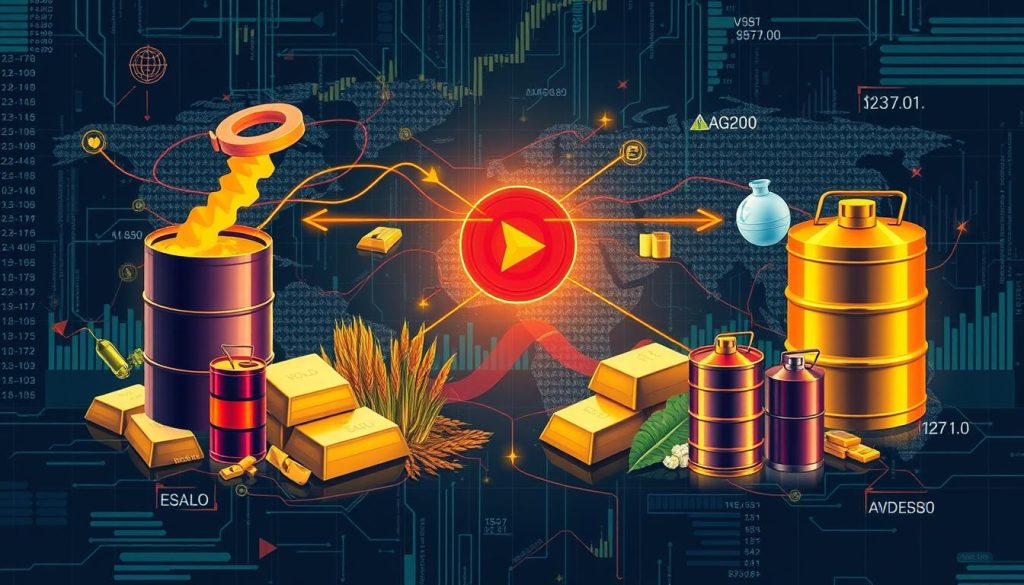In the world of finance, commodity swaps are key tools for managing risks tied to changing prices. These agreements let parties swap cash flows over time, tied to things like oil, gold, or wheat prices1. It’s vital for finance pros to understand these tools well. They help in hedging risks or betting on future price changes.
This guide will cover how commodity swaps work and their strategic uses. It aims to give you the knowledge to trade commodities with confidence. You’ll learn about the basics of swaps, how they’re priced, and the main commodities used. This will help you make better decisions and manage risks well.
Key Takeaways
- Commodity swaps are key for handling risks from changing commodity prices.
- Knowing how swaps work, like the fixed and floating legs, is important for finance pros.
- Swaps are priced by looking at market conditions, volatility, and risk from the other party.
- Choosing the right commodities for swaps, like oil, metals, and crops, is key for good decisions.
- Good risk management for swaps means reducing risks from prices, other parties, and credit issues.
Understanding the Mechanics of Commodity Swaps
Commodity swaps are special deals made outside of formal exchanges and without oversight from exchange regulators2. They are mainly used by big financial institutions because they are complex and big2. These swaps can be based on many commodities, like oil, precious metals, industrial metals, natural gas, livestock, or grains2.
Key Elements of Commodity Swaps
Commodity swaps have key parts that define how they work. These parts include the fixed leg, the floating leg, and the notional amount. Each part is important for the swap’s structure and results.
Fixed Leg
The fixed leg means one party agrees to pay a set price for the commodity over the swap’s term. This makes cash flow predictable and helps reduce the risk from price changes3.
Floating Leg
The floating leg means payments are based on the market price of the commodity, which can change over time. This part adds flexibility and lets parties profit from good price moves in the commodity3.
Notional Amount
The notional amount is the pretend principal used to figure out the cash flows in the swap. It’s what determines the payment duties between the swap’s parties3.
Commodity swaps help parties manage the risk of commodity price changes and get predictable cash flows3. By understanding these complex financial tools, businesses and investors can better handle the changing commodities market and improve their risk management3.
Pricing Mechanisms in Commodity Swaps
Understanding commodity swaps means grasping their complex pricing. Many factors affect their value, from market trends to the trustworthiness of the parties involved. Credit risk challenges, credit risk assessment, and credit risk management are key. They can change the swap’s terms4.
Financial models help predict commodity prices and figure out the swap’s fixed and floating parts. These models consider things like interest rate differences, which affect future payment values4. The risk of one party not fulfilling their part of the deal, or counterparty risk, also matters. It can lead to a higher price because of the added risk5.
Getting the price right in commodity swaps needs a mix of skills. Experts in credit scoring models, credit underwriting, and delinquency prediction must work with those who know the commodity markets well. Keeping up with Basel III compliance and credit risk monitoring helps financial pros make the best choices for their clients45.
“Pricing commodity swaps is a delicate balance, where market insights, financial modeling, and risk management converge to create value for all parties involved.”
The commodity markets are always changing. This means we’ll need better credit risk management and new ways to price commodity swaps. By facing these challenges and using the latest tools, financial experts can handle the complex world of commodity swaps well. They can give great results for their clients6.
Common Commodities in Swaps
Commodity swaps deal with a wide range of items, each with its own market and pricing. The most traded items include oil and gas, precious metals, and farm products7.
Oil and Gas
Oil and gas are very volatile, with prices affected by world events, supply changes, and global energy needs7. The swap market for these commodities has grown a lot. This shows how important they are in the world economy and the need for risk management.
Precious Metals
Precious metals like gold and silver are key in commodity swaps. They are seen as safe investments. This makes them a good choice for investors and businesses looking to reduce risk from price changes.
Agricultural Products
Items like wheat, corn, and soybeans are often in commodity swaps. Their prices change with the weather, crop reports, and global demand8. Swaps help farmers and buyers deal with the risks of price changes. This makes the supply chain more stable and reliable.
Commodity swaps are a big part of the world’s financial scene. They help people manage risks from price changes and improve their risk management798.

“Commodity swaps have become an essential tool for managing the risks associated with price volatility in the global markets.”
Risk Management Strategies for Commodity Swaps
Managing risks with commodity swaps is key. Industry insights10 show that credit risk is big, with borrowers or counterparties possibly not paying back. To deal with these credit risk challenges, banks need strong credit risk management plans, as the Basel Committee10 advises.
Managing risks includes diversification. This means spreading out risks across different areas. Experts suggest using options with swaps too. Options let you buy or sell at a set price, but you don’t have to11.
It’s important to keep an eye on the market and how swaps are doing. This helps in making smart choices and adjusting plans as needed. Regular credit risk monitoring and checking credit portfolios are key for good credit risk management10.
By using these strategies, banks can handle the tricky world of commodity markets and reduce credit risk challenges with commodity swaps10. This helps them stay strong and successful over time10.
| Key Risk Management Strategies for Commodity Swaps |
|---|
|

“Effective risk management is essential for financial institutions dealing with commodity swaps, as it helps mitigate the potential for credit risk challenges and ensures the long-term success of their operations.”
In real-world use, banks must tailor these credit risk management strategies to fit their needs. They need to have the right credit risk assessment and ways to reduce risk for the unique challenges of commodity markets10.
Measuring and Monitoring Commodity Risk
Research shows that11 commodity risk can really affect a company’s finances or position because of price changes. To manage this risk well, companies need to know the different kinds of commodity risk. These include price risk, quantity risk, cost (input) risk, and political risk11.
Using sensitivity analysis can show how bad price moves could hit a company. Studies reveal that12 about half of companies don’t handle their risks well. This shows how important it is to be proactive with credit risk monitoring and credit risk assessment strategies12.
With these detailed credit risk management plans, banks can deal with the complex commodity markets. This ensures they can keep their credit portfolio management and Basel III compliance on track10.
credit risk challenges
Credit risk is a big challenge in commodity swaps. The risk that one party might not pay back can change the swap’s price and risk level13. Banks and traders must check how reliable their partners are and use strong strategies to manage credit risk14.
Managing credit risk in commodity swaps includes using credit valuation adjustments (CVAs) to account for default risk14. Following rules like Basel III is also key to handling credit risk14.
| Top 12 Credit Risk Management Challenges |
|---|
| 1. Regulatory requirements and compliance |
| 2. Data quality and availability |
| 3. Skilled talent shortage |
| 4. Changing market conditions |
| 5. Counterparty risk |
| 6. Accurate risk assessment |
| 7. Lack of standardized processes |
| 8. Legacy systems and infrastructure |
| 9. Fraud and cybersecurity threats |
| 10. Cross-border complexities |
| 11. Risk aggregation and reporting |
| 12. Governance and oversight |
The Leading Credit Risk Management Challenges include following rules, having good data, finding skilled people, and adapting to market changes13. To manage credit risk well, a thorough approach is needed. This includes using new analytics and following new rules14.
“Embracing innovative solutions and fostering a culture of proactive risk management is crucial for financial institutions to navigate the complex landscape of credit risk in commodity swaps.”
Types of Swaps
Swaps are key tools for managing risks in the financial world. They help businesses and investors deal with market changes. There are four main types: interest rate swaps, currency swaps, credit default swaps, and debt-equity swaps. Each type has its own features and uses, which are important for credit risk experts to know.
Interest Rate Swaps
Interest rate swaps let parties swap fixed-rate interest for floating-rate interest. This helps manage risks from interest rate changes. They are the most common type, used to balance out cash flows and reduce interest rate risks15.
If Mary has a better credit score than Paul, it can affect their borrowing costs. There’s a 0.25% difference in floating rates and a 0.75% difference in fixed rates15.
Currency Swaps
Currency swaps help exchange principal and interest in different currencies. This protects against currency value changes. For example, an Australian company needing GBP 10 million can use a currency swap to get the funds, since AUD 20 million equals GBP 10 million at a certain rate15.
Credit Default Swaps
Credit default swaps (CDS) protect against the risk of a debt failing. They are used for bonds or loans16. In 2023, the U.S. CDS market was over $4.3 trillion big16.
The CDS market was over $10 trillion in size by June 2016, says BIS17. CDS can cover a single company or a group of companies agreed upon by both sides17.
Debt-Equity Swaps
Debt-equity swaps swap debt for company shares, often in financial trouble. This swap can turn debt into equity, helping companies recover financially.
Knowing about different swap types is vital for credit risk experts. It helps them manage risks, make smart choices, and follow rules like Basel III.
Conclusion
Exploring commodity swaps shows how vital they are in managing risks across different sectors. You’ve learned about the basics, like the fixed and floating legs, and the notional amount18. You’ve also dived into how they’re priced and the common commodities used18.
Using commodity swaps well means knowing a lot about credit risk18. This includes managing it, scoring models, underwriting, predicting delinquencies, and more18. As the financial world changes, having these skills is key for those in finance19.
Handling credit risk comes with many challenges. These include complex rules, data quality, and finding skilled people18. Markets change fast, and there are risks from others, cyber threats, economic downturns, and needing to match business goals18. By using new tech and balancing risk and return18, you can become a top credit risk expert. This way, you’re ready for the financial world’s changes.
FAQ
What are the key elements of commodity swaps?
Commodity swaps have three main parts: the fixed leg, the floating leg, and the notional amount. The fixed leg means one party pays a set price for the commodity over time. The floating leg is based on the market price of the commodity. The notional amount is the base used to figure out the swap’s cash flows.
How are commodity swaps priced?
Pricing commodity swaps is complex, looking at market factors and swap terms. Financial models help predict commodity prices for the swap’s fixed and floating legs. Interest rates and the risk of one party not fulfilling the swap also affect the price.
What are the most commonly traded commodities in swaps?
Oil and gas, precious metals like gold and silver, and agricultural products like wheat, corn, and soybeans are top commodities in swaps. Each has its own market and pricing, important for managing swap risks.
What are the key risk management strategies for commodity swaps?
Managing swap risks includes diversifying, using options with swaps, and keeping an eye on market trends and swap performance. Handling counterparty and credit risks is also crucial with strong credit management strategies.
What are the different types of swaps used in finance?
Finance uses swaps like commodity swaps, interest rate swaps, currency swaps, credit default swaps (CDS), and debt-equity swaps. Each swap type helps manage different financial risks.
What are the credit risk challenges in the context of commodity swaps?
Credit risk, or the chance a party won’t fulfill the swap, is a big issue with commodity swaps. Financial institutions must check their counterparties’ creditworthiness and use strong credit risk management. This includes credit valuation adjustments (CVAs) and following rules like Basel III.

